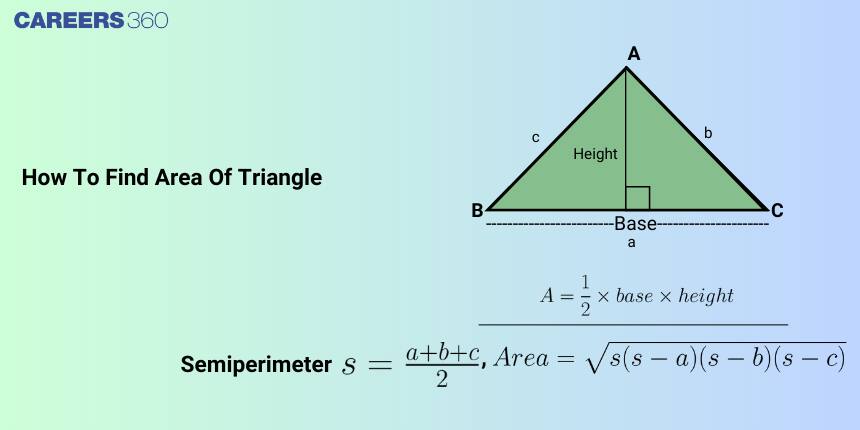How to Find Area of Triangle: Formulas and Examples
In the realm of geometry, the triangle plays a very important part. So, finding the different properties of the triangle is essential. The area of a triangle is the region enclosed by the three sides of the triangle. In real life, we use the area of triangles in traffic signals, truss bridges, and pyramids.
JEE Main 2025: Sample Papers | Mock Tests | PYQs | Study Plan 100 Days
JEE Main 2025: Maths Formulas | Study Materials
JEE Main 2025: Syllabus | Preparation Guide | High Scoring Topics
- What is the Area of the Triangle?
- Area of Triangle Formula
- Area of an Equilateral Triangle
- Area of an Isosceles Triangle
- Area of a Triangle Given Two Sides and the Included Angle (SAS)
- Solved Examples Based on the Area of Triangle

In this article, we will cover the concept of the area of a triangle. This category falls under the broader category of Trigonometry, which is a crucial Chapter in class 11 Mathematics. It is not only essential for board exams but also for competitive exams like the Joint Entrance Examination(JEE Main) and other entrance exams such as SRMJEE, BITSAT, WBJEE, BCECE, and more. Over the last ten years of the JEE Main exam (from 2013 to 2023), a total of six questions have been asked on this concept, including one in 2021.
What is the Area of the Triangle?
The area of a triangle is the region enclosed by the three sides of the triangle. There are many methods by which we can find the area of a triangle such as if the base and height of the triangle are given or three sides of a triangle are given or two sides and an angle enclosed between them is given.
The area of a triangle is usually denoted by
Area of Triangle Formula
The area formula for a triangle is given as
Area =

Area of an Equilateral Triangle
An equilateral triangle is a triangle where all the sides are equal. The perpendicular drawn from the vertex of the triangle to the base divides the base into two equal parts.
Area of an Equilateral Triangle
Area of an Isosceles Triangle
An isosceles triangle has two of its sides equal and also the angles opposite the equal sides are equal.
Area of an Isosceles Triangle =
Area of Triangle with Three Sides (Heron’s Formula)
The area of a triangle with
Consider a triangle

Area of triangle
use half angle formula
Area of a Triangle Given Two Sides and the Included Angle (SAS)

Clearly, height
Area
Area
Area
So area of a triangle is given by
Area
The area of triangle
Thus Area of the triangle is given by
adius of a triangle inscribed in a triangle,
The area of a triangle is given by
where
Recommended Video Based on Area of Triangle:
Solved Examples Based on the Area of Triangle
Example 1: If in a triangle
Solution
Given,
We know,
Using cosine rule.
Now Area
Hence, the correct answer is
Example 2: In triangle
Solution
The area formula for a triangle is given as Area


Area of triangle
NOTE:
Area of the triangle in terms of sides (heron's Formula)
use half angle formula

From the above Diagram, we can see
Hence, the answer is
Example 3: In a triangle,
Solution
Hence, the answer is
Example 4: If the sides of a triangle are the roots of the equation
Solution
As
So, area
Hence, the answer is 0
Example 5: If in a
Solution: Let the altitudes be
Now, the Area of the triangle
So
then
Thus
when k= is some content --------(1)
Now
(1) and (2) we get
Hence, the answer is
Frequently Asked Questions (FAQs)
The area of the triangle is the region enclosed by the three sides of a triangle.
The area of the triangle is given by
Area of triangle
The area of the triangle is given by
Area = Δ = r.s where s is the semi-perimeter of the triangle given by 2s = a+b+c
The area of a triangle if all three sides of a triangle are given by Area
The area of the triangle is given by
Area = Δ = r.s where s is the semi-perimeter of the triangle given by 2s = a+b+c
Area = 5 x 14 = 70
Also Read
15 Feb'25 10:27 AM
15 Feb'25 09:37 AM
13 Feb'25 08:57 PM
13 Feb'25 08:40 PM
13 Feb'25 08:07 PM
13 Feb'25 08:01 PM
13 Feb'25 07:58 PM
13 Feb'25 07:56 PM
13 Feb'25 07:49 PM
13 Feb'25 07:46 PM

